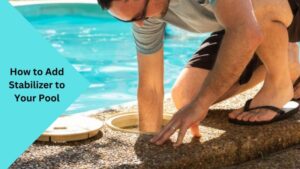Having a well-maintained swimming pool is a source of joy and relaxation during the hot summer months. One essential aspect of pool care is maintaining the right chemical balance, particularly the chlorine level. However, protecting chlorine from the degrading effects of sunlight becomes essential. Enter pool stabilizer, an often overlooked yet crucial component in any pool maintenance routine. In this comprehensive guide, we will explore the various methods of adding stabilizer to your pool, answer common questions, and provide an in-depth understanding of its importance. So, let’s dive in!
- What is Pool Stabilizer?
- How Stabilizer Works
- Why is Pool Stabilizer Important?
- Effects of Sunlight on Chlorine Levels
- How Often to Add Stabilizer to Your Pool?
- Methods to Add Stabilizer to Your Pool
- Can You Add Stabilizer Directly to Your Pool?
- How to Increase Water Stabilizer in Your Pool
- Adding Stabilizer vs. Chlorine – Which Comes First?
- Is Baking Soda a Pool Stabilizer?
- Conclusion
What is Pool Stabilizer?
Pool stabilizer, also known as cyan uric acid, is an essential compound used to protect chlorine from ultraviolet (UV) rays. When added to the pool water, stabilizer creates a shield around chlorine molecules, preventing them from being prematurely degraded by sunlight.
How Stabilizer Works
The stabilizer achieves its protective function by forming a bond with free chlorine. Once this bond is formed, the complex acts as a barrier against the sun’s harmful UV rays. This ensures that chlorine remains effective for a longer period, reducing both chemical waste and the need for frequent chlorine additions.
Why is Pool Stabilizer Important?
The importance of using pool stabilizer cannot be overstated. Without it, chlorine levels can rapidly decrease due to the degrading effects of sunlight. Here’s why stabilizer plays a crucial role in pool maintenance:
Effects of Sunlight on Chlorine Levels

When exposed to direct sunlight, chlorine breaks down rapidly, losing its disinfecting properties. The sun’s UV rays attack and break chlorine molecules apart, rendering them ineffective in killing bacteria and algae. By using pool stabilizer, you create a protective barrier around the chlorine, preventing it from dissipating too quickly.
Prevents Chlorine Loss
Insufficient stabilizer levels in your pool can result in wasteful and inefficient chlorine use. With no protection against sunlight, chlorine quickly dissipates, leading to the need for higher chlorine doses to maintain proper sanitization. By using stabilizer, you reduce chlorine loss, saving both time and money in the long run.
How Often to Add Stabilizer to Your Pool?
Determining the right frequency for adding stabilizer to your pool depends on various factors, such as UV exposure, water temperature, and current stabilizer levels. As a general guideline, it is recommended to test your stabilizer levels every three to four months. If the levels fall below the recommended range, it’s time to add stabilizer.
Methods to Add Stabilizer to Your Pool
Adding stabilizer to your pool is a straightforward process. Below, we outline three common methods to ensure you choose the one that suits your needs best:
Adding Stabilizer Without Skimmer
Adding stabilizer without a skimmer is a viable option for pools without a skimmer system or for those preferring alternative methods. Here’s a step-by-step guide to help you through the process:
- Prepare the stabilizer mixture by dissolving the required amount of stabilizer in a bucket of warm water, following the manufacturer’s guidelines.
- Slowly pour the mixture directly into your pool, distributing it evenly around the perimeter.
- If necessary, use a pool brush or leaf skimmer to help with the dissolution and distribution process.
- Allow the stabilizer to circulate in the water for several hours before testing its levels.
Adding Stabilizer Through the Skimmer
Adding stabilizer through the skimmer is a popular method. It involves introducing the stabilizer granules through the skimmer, allowing them to dissolve and distribute evenly. Follow these steps to add stabilizer using your pool’s skimmer:
- Turn off the pool pump to prevent water flow during the process.
- Following the manufacturer’s instructions, measure the required amount of stabilizer.
- Pour the stabilizer granules into a skimmer sock or pantyhose, creating a secure pouch.
- Place the sock or pouch into the skimmer basket, ensuring it does not block the water flow.
- Turn the pool pump back on, allowing the water to dissolve and carry the stabilizer into the pool.
- Leave the pump running for a few hours to ensure proper distribution before testing the stabilizer levels.
Adding Stabilizer with a Sock
An alternative to using the skimmer is adding stabilizer directly to the pool with a sock. This method allows for quick and even distribution of the stabilizer. Here’s how it’s done:
- Fill a clean sock with the required amount of stabilizer granules.
- Tie the open end of the sock securely to prevent any leakage.
- Carefully place the sock in the pool, ensuring it is in a location with sufficient water flow for proper distribution.
- Allow the water circulation to dissolve the stabilizer and disperse it evenly throughout the pool.
- Leave the sock in the pool for a few hours to ensure complete distribution before removing it.
Can You Add Stabilizer Directly to Your Pool?
Yes, it is possible to add stabilizer directly to your pool. However, there are certain pros and cons to consider:
Pros of Adding Stabilizer Directly
- Convenient: Adding stabilizer directly to the pool eliminates the need for additional tools or equipment.
- Quick Distribution: The stabilizer dissolves rapidly and disperses evenly throughout the water.
- Cost-Effective: This method saves time and money as it doesn’t require any additional accessories.
Cons of Adding Stabilizer Directly
- Precise Measurement: It can be challenging to measure the exact amount of stabilizer needed without using tools like a skimmer sock.
- Dissolution: While the stabilizer dissolves evenly, occasional brushing or manual agitation may be required to ensure complete distribution.
For best results, follow the manufacturer’s instructions and perform pool water tests to verify that the stabilizer levels are within the recommended range.
How to Increase Water Stabilizer in Your Pool
If your pool’s water stabilizer levels are below the desired range, it’s important to increase them to ensure effective chlorine protection. Here’s a step-by-step guide to raising water stabilizer levels:
- Determine the Recommended Level: Check the stabilizer manufacturer’s instructions and recommended range for your pool size.
- Calculate the Required Amount: Based on the recommended level, calculate the amount of stabilizer needed for your pool.
- Pre-dissolve the Stabilizer: Use a clean container filled with warm water to dissolve the required amount of stabilizer.
- Add the Dissolved Stabilizer: Slowly pour the dissolved stabilizer into the pool, distributing it evenly.
- Circulate the Water: Allow the pool pump to run for several hours to ensure proper dissipation and distribution of the stabilizer.
- Test the Stabilizer Levels: After sufficient time has passed, use a test kit to verify that the stabilizer levels have increased within the desired range.
Remember to consult the manufacturer’s instructions for specific guidance on the amount of stabilizer to use, as it varies based on pool size and desired stabilizer levels.
Adding Stabilizer vs. Chlorine – Which Comes First?
When it comes to adding stabilizer and chlorine to your pool, the order of application matters. To ensure effective chemical balance, it is recommended to follow this sequence:
- Add Stabilizer: Begin by adding the required amount of stabilizer to the pool water according to the manufacturer’s guidelines.
- Test Stabilizer Levels: After circulation and dissipation, test the stabilizer levels with a test kit to ensure they fall within the recommended range.
- Add Chlorine: Only after verifying the stabilizer levels should you add chlorine to the pool. Begin by adding the desired amount of chlorine according to the manufacturer’s instructions.
- Monitor Chlorine Levels: Regularly test chlorine levels to maintain the proper balance and adjust as necessary.
Following this sequence allows the stabilizer to form a protective barrier around the chlorine, maximizing its effectiveness and lifespan.
Is Baking Soda a Pool Stabilizer?
No, baking soda is not a pool stabilizer. Baking soda, also known as sodium bicarbonate, is primarily used to increase the pH levels in pools. Its main purpose is to maintain the appropriate alkalinity levels, providing a stable environment for the other pool chemicals to work optimally. Stabilizer, on the other hand, is specifically designed to protect chlorine against UV rays. It is important to differentiate between the two and use them accordingly to maintain proper pool chemistry.
Related post for you : How Can I Raise the Chlorine in My Swimming Pool? Mastering Chlorine Maintenance
Conclusion
Maintaining a properly balanced pool is essential for enjoyable and safe swimming experiences. Adding stabilizer to your pool is a crucial step in ensuring the longevity and effectiveness of your chlorine. By forming a protective shield around chlorine molecules, stabilizer prolongs the disinfecting power and reduces chlorine waste caused by sunlight. This comprehensive guide has covered everything you need to know about pool stabilizer, including its importance, different methods of adding stabilizer, and the proper sequence for adding chemicals. Remember to refer back to this guide whenever you need a refresher on maintaining a perfectly balanced pool. Happy swimming!

Greetings, fellow pool enthusiasts! I’m Turner Davis, your dedicated guide to the world of pool care and maintenance. With over a decade of experience in the field, I’ve made it my mission to transform ordinary pools into extraordinary aquatic retreats.

